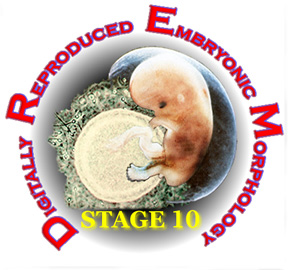

| Opening Screen | Embryo 6330 Figures | Download Section Images |
| Browse Sections | Flythrough Animations | Help / Instructions |
| 3D Models | Credits |
 |
||
|
Stage 10 embryos have a greatest length of 1.5 to 3.6 mm and an estimated postfertilization age of 28 to 30 days. There are 4 to 12 pairs of somites along the body axis. The neural tube has begun to form and has rostral and caudal neuropores. The five major subdivisions of the brain can be identified in the neural folds. The optic sulcus is present with a chiasmatic plate in the midline. The first pharyngeal pouch is close to the relatively large otic placode. Presumptive left and right atria and ventricles of the heart can be identified by their relative locations. The epimyocardium and the bulbotruncus region are present. The stomodeum, thyroid gland primordium, laryngotracheal sulcus and hepatic plate are all present. The nephrogenic cord or intermediate mesoderm can be identified lateral to the somites. There is no evidence of limb buds. Stage 10 is represented in the DREM databases by Carnegie embryo # 6330 that was given a grade of good. It was selected for digital replication because it is considered to be one of the top three specimens at stage 10 in the collection. While the age of the embryo is estimated to be 28 postfertilization days the specimen is considered to be representative of the middle part of the stage. It has a greatest length of 2.83 mm (after fixation) and there are seven somites along the body axis. This embryo was prepared for microscopic examination in 1931 and was originally part of the collection at the University of Chicago (No. H 1404). This specimen was fixed in formol, embedded in celloidin and paraffin and serially sectioned transverse to the long axis at 5 microns. The 425 sections were mounted on four large, glass slides and stained with Ehrlich’s acid hematoxylin. The morphology of this embryo has not been well documented in the literature. The Carnegie Collection contains some photographs of the embryo before it was sectioned. This DREM database includes 170 of the 425 sections. Approximately every third section was digitally restored and labeled, and can be viewed at four magnifications (3 zoom levels on the CD version). Also included on the disks are an animated 3D reconstruction of the embryo surface and a flythrough animation of the aligned sections. For anyone who wishes to use them for other reconstructions, research or presentations, the original section images are available as individual .jpg files. These files are zipped as a complete set of all 425 sections, or as individual slide sets. Instructions for using the disks can be found by going to theInstructions section from the opening screen. |
||